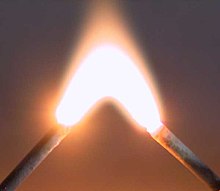History and Characteristics of Electric Arc
– Natural lightning is now considered an electric spark, not an arc.
– Sir Humphry Davy discovered the short-pulse electrical arc in 1800.
– In 1801, he described the phenomenon in a paper published in William Nicholsons Journal of Natural Philosophy, Chemistry and the Arts.
– Davy publicly demonstrated the effect by transmitting an electric current through two carbon rods and pulling them apart, producing a feeble arc.
– The first continuous arc was discovered independently in 1802 by Vasily V. Petrov, a Russian scientist experimenting with a copper-zinc battery.
– An electric arc is the form of electric discharge with the highest current density.
– The breakdown voltage of the electrode gap is a combined function of pressure, distance between electrodes, and type of gas.
– An arc in gases near atmospheric pressure is characterized by visible light emission, high current density, and high temperature.
– A drawn arc can be initiated by two electrodes initially in contact and drawn apart.
– Electrical resistance along the continuous electric arc creates heat, which ionizes more gas molecules.
Applications of Electric Arc
– Electric arc lighting was widely used for public lighting in the late 19th century.
– Low-pressure electric arcs are used in applications such as fluorescent tubes and metal-halide lamps for lighting.
– Electric arcs can be utilized for manufacturing processes, such as electric arc welding and electric arc furnaces for steel recycling.
– Xenon arc lamps have been used for movie projectors.
– Techniques for arc suppression can be used to reduce the duration or likelihood of arc formation.
Structure and Behavior of Electric Arc
– An electric arc has little discernible structure, with a bright positive column extending nearly to the electrodes.
– The current in the arc is sustained by thermionic emission and field emission of electrons at the cathode.
– The positive column has a lower voltage gradient and may be absent in very short arcs.
– The shape of electric arcs is emergent properties of non-linear patterns of current and electric field.
– An electric arc has a non-linear relationship between current and voltage.
Comparison with Glow Discharge
– An arc discharge is characterized by a lower voltage than a glow discharge.
– The positive ions in an arc discharge are much colder than the electrons, unlike in a glow discharge.
– An electric arc differs from a glow discharge in that the current density is high and the voltage drop within the arc is low.
– An electric arc is a continuous discharge, while an electric spark discharge is momentary.
– The current vs. voltage characteristic of an electric arc becomes more nearly ohmic at higher frequencies.
Protection, Visual Entertainment, Guiding the Arc, and Undesired Arcing
– Spark gaps, Jacobs ladder, compressed air or gas blasts, and high-voltage switches are used to protect against and extinguish arcs.
– Jacobs ladder is a device that produces continuous electric arcs, creating an exotic display of colors.
– Laser beams can be used to guide the arc and shape its path.
– Undesired arcing can have detrimental effects and various techniques are used to prevent or reduce it.
– Arc susceptibility can be tested and different materials have different arc resistance.
– Arc suppression methods are used to reduce or eliminate electrical arcs and their harmful effects.
– Arc-producing devices can pose health hazards due to the formation of reactive molecules like ozone and nitric oxide. Source: https://en.wikipedia.org/wiki/Electric_arc
An electric arc (or arc discharge) is an electrical breakdown of a gas that produces a prolonged electrical discharge. The current through a normally nonconductive medium such as air produces a plasma, which may produce visible light. An arc discharge is initiated either by thermionic emission or by field emission. After initiation, the arc relies on thermionic emission of electrons from the electrodes supporting the arc. An arc discharge is characterized by a lower voltage than a glow discharge. An archaic term is voltaic arc, as used in the phrase "voltaic arc lamp".

Techniques for arc suppression can be used to reduce the duration or likelihood of arc formation.
In the late 19th century, electric arc lighting was in wide use for public lighting. Some low-pressure electric arcs are used in many applications. For example, fluorescent tubes, mercury, sodium, and metal-halide lamps are used for lighting; xenon arc lamps have been used for movie projectors. Electric arcs can be utilized for manufacturing processes, such as electric arc welding, and electric arc furnaces for steel recycling.
